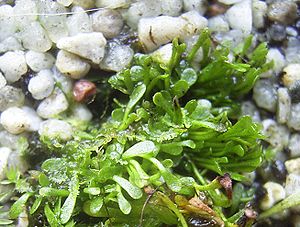Genlisea aurea
| Genlisea aurea | ||||||||||||
|---|---|---|---|---|---|---|---|---|---|---|---|---|

Genlisea aurea |
||||||||||||
| Systematics | ||||||||||||
|
||||||||||||
| Scientific name | ||||||||||||
| Genlisea aurea | ||||||||||||
| A.St.-Hil. |
Genlisea aurea is a carnivorous plant from the genus of trap traps ( Genlisea ). It is also called the yellow trap trap in German-speaking countries.
In addition to Genlisea violacea and Genlisea margaretae , Genlisea aurea was one of the three species in which Wilhelm Barthlott demonstrated the long-suspected carnivory of the genus in 1998 .
description
Vegetative characteristics
Genlisea aurea is a perennial, herbaceous plant , relatively strong for a trap species and reaches a height of 10 to 30 (rarely 9 to over 55) centimeters. The completely underground, corkscrew-like twisted traps, the so-called rhizophylls, reach a length of 10.7 centimeters, with a more or less egg-shaped thickening and ensure that prey is caught by attracting microorganisms such as ciliates .
The leaves are almost fan-shaped in a dense, mucous-covered rosette and have a long, completely underground petiole . They are spatulate, occasionally inverted-ovate spatulate, tapering towards the base of the leaf, the tip is occasionally truncated or notched. The leaves are between 5 and 50 millimeters long and 0.5 to 2 (rarely up to 4.5) millimeters wide.
Generative characteristics
The up to 55 centimeters high, hairy inflorescence axis bears four to six (rarely one to eleven) yolk to golden yellow flowers . The stem is covered with groups of multicellular glandular hairs at the base, rarely and sparsely also with multicellular non-glandular hairs that accumulate at the tip of the inflorescence axis. There are one to twelve bracts along the stem , they are covered with both types of hair on the edge and back, ovoid to lanceolate, usually tapering to a point, but occasionally blunt or notched, 2.5 to 3.5 (1.5 to 6, 5) millimeters long and 0.5 to 1 (1.5) millimeters wide. The always upright pedicels are around 5 (2 to 25) millimeters long and covered with glandular and isolated non-glandular hairs, bracts are also found here, they are similar to those of the inflorescence axis, but are 2 (1.5 to 4) millimeters long and 1 ( 0.5 to 2.3) millimeters wide. The two bracts are hairy, 2 (1.2 to 3.5) millimeters long, 0.5 (0.3 to 1.3) millimeters wide, generally oblong-round or ovate to lanceolate, rarely linear-lanceolate, the Point can be blunt to pointy.
distribution
Genlisea aurea is native to Brazil , it occurs in the states of Mato Grosso , Bahia and Santa Catarina . There it grows at altitudes between 550 and 2550 m. It prefers a semi-aquatic, partially submerged way of life in acidic humus soils.
genetics
The number of chromosomes is 2n = approx. 52 specified. With 63.6 Mbp for Genlisea aurea , the species contains the second smallest known genome of all flowering plants (only slightly undercut by 63.4 Mbp for Genlisea margaretae ). Also noteworthy is the size of the individual chromosomes , which at 2.1 Mbp are in the order of magnitude of bacteria .
etymology
The generic name Genlisea honors the French writer Stéphanie-Félicité de Genlis (1746-1830). The species name ( epithet ) aurea is derived from the Latin word aurum for "gold" and describes the bright yellow flowers.
literature
- Elza Fromm Trinta: Revisão Das Espécies Do Gênero Genlisea St. - Hil. (Lentibulariaceae) The Regiões Sudeste E Sul Do Brasil. In: Rodriguésia. Vol. 31, No. 49, 1978, ISSN 0370-6583 , pp. 106-109, JSTOR 23493200 .
- Fernando Rivadavia: Genlisea aurea St. Hil. In: Carnivorous Plant Newsletter. Vol. 31, No. 2, 2002, ISSN 0190-9215 , pp. 54-56 .
Individual evidence
- ↑ Birgit Gemeinholzer: Systematics of plants compact . Springer-Verlag, Stuttgart 2019, ISBN 9783662552346 , page 294.
- ^ Wilhelm Barthlott , Stefan Porembski, Eberhard Fischer, Björn Gemmel: First protozoa-trapping plant found. In: Nature . Vol. 392, No. 6675, 1998, p. 447, doi : 10.1038 / 33037 .
- ↑ Fernando Rivadavia: Genlisea aurea St. Hil , in: Carnivorous Plant Newsletter , 31st edition, 2nd quarter, Walnut Creek (Cal.) 2002, ISSN 0190-9215, pp. 54-56.
- ↑ Johann Greilhuber, Thomas Borsch, Kai Müller, Andreas Worberg, Stefan Porembski, Wilhelm Barthlott: Smallest angiosperm genome Found in Lentibulariaceae, with Chromosomes of Bacterial size. In: Plant Biology. Vol. 8, No. 6, 2006, pp. 770-777, doi : 10.1055 / s-2006-924101 .
- ↑ Helmut Genaust: Etymological dictionary of botanical plant names . Springer-Verlag, Berlin 2013 (3rd edition), ISBN 9783034892827 , pages 162 & 263.